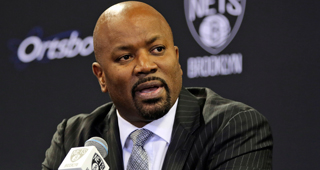The Brooklyn Nets are now two seasons removed from going all-in and attempting to win a title when they traded three first round picks and the rights to swap picks to Boston for one season of Paul Pierce, a season a half of Kevin Garnett and a partial season of Jason Terry. This is after trading future picks and swaps to the Atlanta Hawks for Joe Johnson only a year earlier. This series of moves resulted in winning one playoff series. While you can appreciate a team going for it, you can also see how failing at that goal can set a franchise back for years.
The Nets are moving on from this strategy. They no longer have any of the players from the Boston deal. They have also released Deron Williams via the Stretch Provision. From a group that hoped to be a title contender, only an aging Joe Johnson and an oft-injured Brook Lopez remain. Considering they were floundering at the bottom of the Eastern Conference playoff picture, it was time to make some changes.
The Nets goals this offseason were simple: Shed bad contracts if they could, and don’t take on any new ones. Depending on your views on Brook Lopez and Thaddeus Young (more on them later), they seem to have achieved that goal.
At the draft, the Hawks exercised their right to swap picks, bumping the Nets back from 15 to 29. The Nets still ended up having a solid draft despite dropping 14 slots. First, they traded Mason Plumlee and a second round pick (which turned out to be Pat Connaughton) to Portland for Steve Blake, or at least his contract, and the Drat Rights to Rondae Hollis-Jefferson. Considering Plumlee’s play had fallen off during the previous season, the Nets got a good player who had slipped in the draft in return for him. Later on, with the pick they received from Atlanta in the swap, Brooklyn drafted Chris McCullough. McCullough will miss a chunk of the season recovering from a torn ACL. If he recovers fully, the Nets may have the steal of the draft.
Once free agency began, Brooklyn was staring at the potential of another massive luxury tax bill. With all of their upcoming picks headed to Boston, there was little sense to be made of a complete tear down. With no foreseeable cap space and not much in terms of trade assets, the future seemed bleak. However, the Nets were able to rebound and have a fairly productive summer.
First up, the Nets brought back Brook Lopez and Thaddeus Young. With no way to bring in outside free agents beyond exceptions, the Nets’ best bet at remaining relevant was to bring back their two major free agents. Both Lopez and Young got reasonable deals. Lopez got the maximum for three years. That is a fine deal for one of the better offensive centers in the game. When healthy, he’s a player that the Nets can build an offense around. Young is a very solid power forward, who can also play some small forward. His deal pays an average of $12.5 million for the next four seasons. That is an acceptable number for a player of his caliber, considering the rising cap. Both players have an out with player options on the final year of each of their deals.
Following those two moves, Brooklyn was committed to trying to remain a playoff team. They then brought in complementary pieces in Thomas Robinson (who the team had chased for a couple of seasons), Shane Larkin, and Wayne Ellington. Robinson adds a rebounder off the bench. Larkin, after having his third year rookie option declined by New York, can be the backup PG. And Ellington can be a shooter off the bench behind Joe Johnson and Bojan Bogdanovic. The Nets then spun off the recently acquired Steve Blake to the Pistons for Quincy Miller. This amounted to basically shedding a fully guaranteed deal for a partially guaranteed one.
The final “big” addition was to add Andrea Bargnani. On a Veteran Minimum deal, the Nets can’t really go wrong here. Assuming Bargnani can add offense and shooting off the bench behind Lopez and Young, Brooklyn will have hit cheap on a solid signing. If not, the investment was fairly minimal. To round out the additions, the Nets added Summer League standout Willie Reed and rookie free agent, Ryan Boatright. Reed has had a few shots at the league and hasn’t been able to stick. This time around, he could prove to be worthy of a fifth or sixth big man spot. Boatright is a developmental prospect at PG. Donald Sloan was also added to bring competition to the backup point guard spot behind Jarrett Jack and Shane Larkin.
Why is Jarrett Jack now the starting point guard in Brooklyn? That is because of the Nets most surprising move of the offseason; the release of Deron Williams. The team was ready to move on from Williams, but there were no takers for his contract. Without any assets to add in the form of picks or young talent as incentive, the Nets had no real way of trading Williams. Williams was also ready to move on and preferred to be in a place where he was wanted. With this in mind, both parties agreed to a buyout and Brooklyn used the Stretch Provision on Williams. Williams will count on the Nets cap for the next five years at approximately $5.5 million. Considering how far south the partnership had gone, that was the best possible result.
The other players moving on will be missed more for what they could have been, as opposed to what they actually were. Mirza Teletovic had flashes and looked good at time before missing a large chunk of last season with blood clots. He’s basically a stretch PF who is a liability defensively when asked to play big minutes. His minutes will be absorbed by Andrea Bargnani for a much smaller price. Alan Anderson moved on to the Wizards. He was very solid bench wing for the Nets for two seasons. The development of Bogdanovic and drafting of Hollis-Jefferson made him expendable. As covered above, Plumlee seemed to have lost his luster. At this point, it looks like he’s a bench big man. Again, the Nets will get similar production for less cost from Thomas Robinson.
Offseason Grade: B-. This grade may at first seem generous for a team that retained two free agents and added only role players, especially when that team was fortunate to make the playoffs last year. But this grade isn’t just about what the Nets added versus what they lost. They may not be a better team this year than last year, but they should remain in the mix for the eight seed in the Eastern Conference. That probably says more about the bottom of the East, however, than it does about Brooklyn.
What the Nets did was put themselves in a better position to be better in a year. By removing some of their big salaries and replacing them with far smaller deals, the Nets should be able to get under the Luxury Tax. A year after paying over $90 million in tax payments, that is no small accomplishment. To have done it without significantly weakening the team is an even bigger accomplishment. And, finally, to have done it without any assets in terms of draft picks or young talent is even more impressive. Add it all up, and while the results may not be better on the court this year, Brooklyn is now set up to be a major player in free agency next summer with plenty of cap space and no fear of the repeater tax. And to have a better chance at being better is all a team with no real assets can really ask for.



